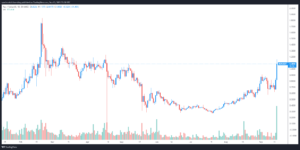This article on Objective Trading Strategy and Meme Stocks is the opinion of Optimus Futures.
- Meme stocks appear to be the latest “craze” in retail trading–and that’s what makes it so dangerous for those who don’t know what they’re doing.
- When trading meme stocks, understanding the true objective behind the trade might help you better manage your risks and set your profit targets.
- Trading on gut instinct or FOMO is perhaps the worst thing you can do when trading meme stocks.
Then you saw it unfold. From the opening price of $39.23 on January 21, GME spiked to as high as $483 five days later. That was an astounding move of 1,131%! You shrug it off as an odd if not rare event, one that you unfortunately missed.
But then it happened several times across several stocks:
AMC Entertainment (AMC) spiked 431% from May 24 to June 2
Blackberry (BB) spiked 114% from May 26 to June 4
Workhorse (WKHS) jumped 128% from May 26 to June 9
Clover Health Investments (CLOV) spiked up to 270% before pulling back from June 2 to June 9
Sundial Growers (SNDL) surged as high as 94% from May 26 to June 3 before pulling back on that same day
FOMO–or the “Fear of Missing Out”–hits you hard after seeing these returns. You seem to be missing out on all of these opportunities in which people have experienced outsized gains; though others may have experienced devastating losses.
Truly, when everyone seems to be making money around you–and the chatter can be heard virtually anywhere, from news to blogs to even your local cafe–it’s hard to keep your head. It’s difficult to resist the temptation to jump in and follow the crowd.
But is it a wise thing to do? Better yet, is there a smarter way to take advantage of these risky “meme stocks”? Perhaps there is. And that’s what we’re going to explore in this article.
What Are “Meme” Stocks?
To understand what a meme stock is, you first have to know what a “meme” is. A meme is any form of digital content–an image, video, text, etc.–that is copied and spread on social media. Meme’s are often humorous but they can also spread messages of a serious nature, as in the case with political or social memes.
A meme stock, on the other hand, is a stock whose promotion on social media–often via meme–has gone “viral,” causing it to experience excessive trading volume.
Although online messaging among traders has existed since the beginnings of trading chat rooms, meme stocks carry a different characteristic: their origination often stems from a particular “feed” or channel (like Wallstreetbets), they’re supported by a critical mass of traders large enough to move the markets, and they’re often, though not always, accompanied by social, political, or ideological motivations that exceed pure speculation.
The GME short squeeze, for instance, was virtually an attempt to “stick it to the man”–in this case, the “man” being the amorphous Wall Street “elites” who many of Wallstreetbets’ followers felt were “rigging” the stock market. For some, it worked out well. For others, it might have been a disaster.
Fueled by Fundamentals or FOMO Frenzy?
If you’ve seen what successful meme stock swarms can do, you can imagine how easy it is to get sucked into the frenzy. In the midst of the temptation to jump in, however, it’s also easy to forget just how volatile and difficult the trade may be.
So, if you’re looking to get in, you’d better have a good idea as to how large a position you should hold based on your risk tolerance, and certainly have a plan for getting out should the trade move against you.
The GME frenzy provides a perfect example. Let’s dissect the trade.
If you had bought here [1], at around $140 a share, then you would have seen your position lose almost half its value in one day, as it ended the day at $76.79. Ouch.
But then, if you sold it at $76.79, you would have missed all of the market price action in the box [2] which took GME as high as $483 a share before sinking back down to $51 less than two weeks later.
Right now, GME is trading at around $300. But let’s hold off for a moment and think: why would anyone want to buy GME in the first place?
GME is a mall or stripmall based gaming store that was largely shuttered during the Covid pandemic. Malls were closed during the lockdown. Revenue and earnings suffered for two quarters in a row as a result, and the prospects for reopening were, at the time, unknown, as vaccination rollouts were just starting to get underway.
Arguably, there was nothing fundamentally compelling about GME’s prospects.
The Wallstreetbets crowd bought GME because someone in the industry leaked information that a few hedge funds were heavily short GME. The strategy was to force these hedge funds into a short squeeze–profiting from the ensuing price surge as hedge funds were forced to cover their positions.
The call was a real gamble, as it required a critical mass of traders to manipulate GME’s price upwards. But as you saw, traders swarmed, and it worked.
Most importantly, the GME trade was never about the underlying strength of the company. It was about exploiting the suspected vulnerability in hedge funds’ short positions.
Was it a wise trade? It depends on your objectives, risk tolerance, and capital resources.
An Objective Trading Strategy (or, How Not to Lose Your Head with Meme Stocks)
For most traders, meme stocks represent the potential to make outsized profits well over a 100% return in a very short amount of time. That’s tempting. Although such an outcome is indeed possible, bear in mind that such a return is well beyond the norm…and so too are the potential risks.
So, here are a few tips to help you keep your head while engaging in a meme stock trade.
Tip #1: Understand the nature of the trade
Is a meme stock truly undervalued, or is it a secondary vehicle to pursue another objective, such as raiding a hedge fund’s short position. If it’s both (as the silver squeeze attempt was), then it may be a favorable trade, given the proper risk management.
Tip #2: Do a quick survey of the fundamentals
Check the company’s previous quarterly earnings history, find out what consensus expectations are for both revenue and earnings per share, research company guidance (which can be found in the last quarter’s CNBC guidance reporting), and if you can, get a feel for what the company is trying to accomplish in the current quarter by reading the previous quarter’s earnings conference call transcript.
If you can do all of the above–roughly two hours of work–then you may have more confidence to proceed with (or withhold from) making the trade.
Tip #3: Watch your position size
Meme stock trades don’t happen frequently, so you can risk a little more as compared with a day trade. Whatever the percentage risk you’re willing to take on, say 2% or more, stick to it. Don’t risk more than you can afford to lose. However, considering the potential for an exponential move, you might want to make sure your position size is worth the trade.
Tip #4: Set your risk limits and trade boundaries
This one should be relatively easy: set a stop loss at a point where the trade is no longer valid. Bear in mind that if you’re going after hedge funds, they may push back and attempt to plunge the stock, so be ready to absorb that shock should it take place.
Disclaimer: The placement of contingent orders by you or broker, or trading advisor, such as a “stop-loss” or “stop-limit” order, will not necessarily limit your losses to the intended amounts, since market conditions may make it impossible to execute such orders.
Tip #5: Consider trading options rather than outright positions
Option prices tend to move exponentially until they’re “in the money,” and this might give you more bang for your buck. Furthermore, when purchasing a call (as most meme stock trades have a “long” bias), you know beforehand how much you may lose in premium.
Another thing to consider is that you can also buy a bull spread to reduce your cost and your risk. Or if you’re unsure as to the directionality of the outcome, you can always straddle the position, though, again, most meme stocks have an upside bias, and straddles can get expensive depending on the volatility.
Disclaimer: Long Optin may expire and you may lose your entire premium plus cost. Short Options have unlimited risk and you may sustain a loss substantially bigger than your initial deposit.
Tip #6: Never use your gut when trading meme stocks
This is perhaps the worst thing you can do: hear a rumor and enter a trade. Always trade based on a setup (usually technical since not all meme stock trades heed fundamentals as we saw with GME). This implies rules and risk limits. If you deviate from this basic principle and trade from impulse of gut, you’ll eventually pay for it in either real loss or opportunity cost.
The Bottom Line
Trading meme stocks may seem like a gamble. The truth is that it can be, or you can transform it from a gamble to a “high risk” trade by taking a smarter approach. When trading meme stocks, the volatility of the swarm action can be massive enough to shatter any “clean” chart setup you may have on your mind prior to the trade. So, be sure to set your risk limits and profit targets, and try to understand something about the stock before you trade it.
By all means, do NOT trade from the gut or be tempted to jump in unprepared out of sheer FOMO. Good luck!
Disclaimer: There is a substantial risk of loss in futures trading. Past performance is not indicative of future results.
Source: https://optimusfutures.com/tradeblog/archives/how-to-stay-objective-with-your-trading-strategy/%20- 7
- 9
- Action
- ADvantage
- advisor
- All
- among
- around
- article
- blogs
- Box
- broker
- buy
- call
- capital
- chat rooms
- closed
- CNBC
- company
- Conference
- confidence
- Consensus
- Covid
- Current
- day
- digital
- disaster
- Earnings
- Entertainment
- etc
- Event
- First
- follow
- FOMO
- form
- Fundamentals
- funds
- future
- Futures
- GAMESTOP
- gaming
- good
- growers
- head
- Health
- Hedge Funds
- here
- High
- history
- hold
- How
- How To
- HTTPS
- idea
- image
- industry
- information
- Investments
- IT
- jump
- large
- latest
- local
- lockdown
- Long
- Making
- management
- Market
- Markets
- Media
- meme
- memes
- messaging
- money
- move
- news
- online
- Opinion
- Opportunity
- Options
- order
- orders
- Other
- Others
- pandemic
- Pay
- People
- performance
- Premium
- price
- price surge
- Profit
- promotion
- pulling
- Reading
- reduce
- research
- Resources
- Results
- retail
- returns
- revenue
- Risk
- risk management
- Rooms
- rules
- secondary
- set
- Share
- Short
- Silver
- Size
- So
- Social
- social media
- sold
- spread
- stay
- stock
- stock market
- Stocks
- store
- Strategy
- street
- successful
- Supported
- surge
- Survey
- suspected
- Swarm
- Technical
- time
- tips
- tolerance
- trade
- Traders
- trades
- Trading
- Transcript
- value
- vehicle
- Video
- Volatility
- volume
- vulnerability
- Wall Street
- WallStreetBets
- Watch
- WHO
- worth












